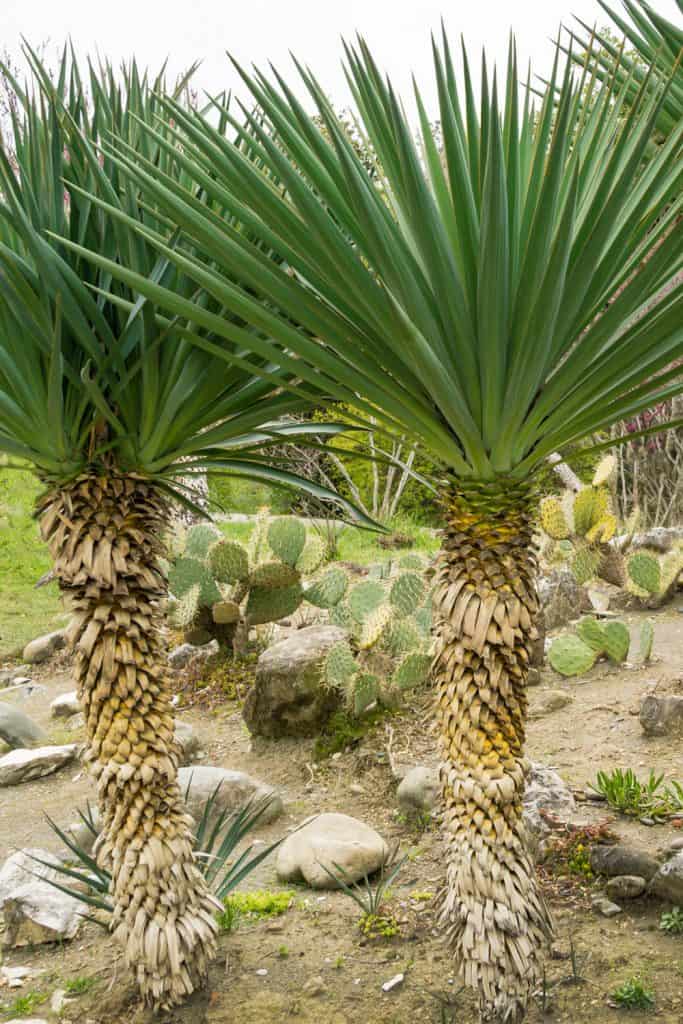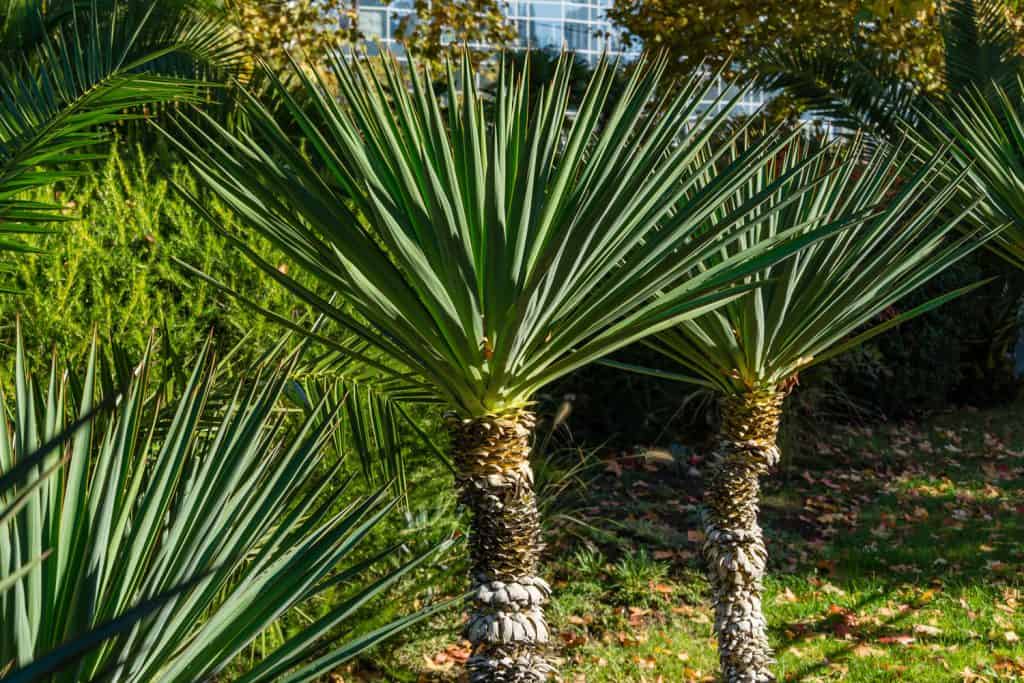Perhaps you find yourself designing a brand new landscape for your Florida home, or perhaps you are simply ready to spice up your existing landscape. Either way, you are wondering if the popular plant yucca grows in Florida and whether or not it is native. In this post, we gather up-to-date research to answer your question.
Yucca plants grow very well in Florida. In fact, three species of yucca are native to Florida. They are the mound Spanish dagger, Spanish bayonet, and Adam’s needle yuccas. This makes yucca an attractive and easy-to-care-for addition to most home landscapes.
Keep reading the rest of this post for details on the three species of yucca native to Florida. These details include cultivation advice, expected growing pattern, and preferred habitat. In addition, we answer several other questions that will help with your yucca cultivation goals.

Native Floridian Yucca
While many species of yucca grow well in Florida, the native species of yucca offer a wide range of shapes to fit most landscaping needs. Generally, yuccas have very spikey leaves and edible flowers arranged on a long stem. Interestingly, the sharp nature of yucca leaves is well captured in the common names of Florida's native yucca.

All three of the native species of yucca are drought and disease-tolerant, making them easy additions to any yard. Further, cultivating any of these three species is a great way to help indigenous plants thrive and to provide habitat for native butterflies. For reference, Florida ranges from USDA Plant Hardiness Zone 8 through 10. Read the following sub-sections to learn more about each of these three yucca species.
To help your native yucca grow bigger and faster, consider a fertilizer. Read this article for a great collection of advice on yucca fertilizer, "5 Of The Best Fertilizers For A Yucca Plant." Sometimes, even a yucca that you think you are caring for well will not flower. Read this great article to learn how to fix that issue, "Yucca Not Flowering – What To Do?"
Mount Spanish Dagger
Mount Spanish dagger is also known as mound lily yucca; the scientific name is Y. gloriosa. This yucca species is hardy in zones 6 through 11. Mound lily is unique for its drooping leaves that are not as sharp and dangerous as the other native Florida yuccas. The flowers of mount Spanish dagger are purple and white and bloom in the hot summer months.

This species grows on the slower end of yucca and prefers full sun. However, it is reported to tolerate partial shade as well. Generally, mount Spanish dagger reaches a height of six to eight feet tall and takes up four to eight feet in diameter.
Spanish Bayonet
Spanish bayonet is also known as Spanish dagger; the scientific name is Y. aloifolia. This species is unique as it can reach a height of 20 feet tall. Further, the wide crown of leaves even provides some shade. Take care, the leaves of this plant are very sharp. Sometimes, gardeners will even trim off the terminal point for safety's sake.

Spanish bayonet is tolerant in zones 6 through 11 but does require a lot of growing space and air movement. Further, this plant does not do well if irrigated but does tolerate full-sun to full-shade and even very salty air. The large spikey nature of this yucca makes it a favored plant for buffer screens.
Adam's Needle
The final species of native Floridian yucca is Adam's needle or Y. filamentosa. This species of yucca has no main stem but still has leaves that can grow up to three feet tall. In contrast to the other two species of Florida yucca, Adam's needle is hardy from zones 7b through 10.

Adam's needle prefers very dry areas and full sun - making it a perfect addition to a low-maintenance sunny garden. It flowers out of a tall central stem and produces stunning bell-shaped blossoms. It will propagate itself through underground runners to form colonies in favorable conditions.
What zone does yucca grow in?
Yucca is a very hardy and variable plant type. In fact, yucca can survive and thrive in hardiness zones 3 through 11. Before you plant your yucca outside, ensure that the species you have purchased is appropriate for your area. Check out this map from the USDA to see which hardiness zone you live in.
The hardiness zone is just one of the many factors that contribute to whether a yucca or any plant will survive. Research the specific plant/yucca you intend to plant both through internet searches or for a great resource, head down to your local nursery.
Can yucca survive winter?
Yes, depending on your hardiness zone, yucca can survive the winter outdoors. However, and as discussed throughout this post, not all yucca species or locations are equal. Take the time to research and buy a yucca that is appropriate for your area. Generally, the hardiness zone is an indication of whether a plant will survive winter or not.
Are yuccas invasive?
Yes, some species of yuccas are invasive. Yucca is a very hardy plant that often withstands difficult conditions like low water and high temperature. Couple this with its natural resistance to insects and animals, and you get a plant that is good at surviving.
This is a problem because of the strong invasive root systems that some yucca have. These roots are known to break apart foundations and tilt-up sidewalks. Once established, it is very difficult to fully remove the yucca root. For this reason, only plant certain types of yucca further away from structures. To learn what types of yucca are invasive in your area, take the time to visit an expert at a local gardening store.
What kills a yucca plant?
When you have an invasive or unwanted yucca plant on your hands - the only choice is to kill the plant. Unfortunately, this is not a simple matter of uprooting, digging up, or cutting down the yucca. This is because if even a little bit of living root remains, the plant will re-establish. Instead, combine traditional techniques with herbicide and/or stump remover.
Click here for a well-reviewed stump remover from Amazon.
First, cut down the yucca plant using a saw or hatchet. Once you have the main body of the plant removed, drill several holes into the remaining stump. Pour stump remover or herbicide into these holes. Eventually, this will spread throughout the root system and kill the plant. Take note; you might have to perform several attempts before fully killing the yucca.
Where is the best place to plant a yucca?
The best place to plant a yucca plant depends on the type of yucca you have. Some yucca thrive in full sun, while others prefer partial shade. Further, the soil type makes a difference. While most yuccas prefer dry sandy soil, this is not universally the case.

Instead, plant your yucca in a place that gives it room to grow to its full size and that appeals to its natural habitat. This depends on the species of yucca. Research your particular species or ask a local gardening professional to determine the perfect place for your yucca.
In Closing
In this post, we have covered whether or not yucca grows well in Florida. In addition, we answer the question of if yucca is native to Florida and include an introduction to the three native Floridian species. We also answer several related questions. Good luck!

